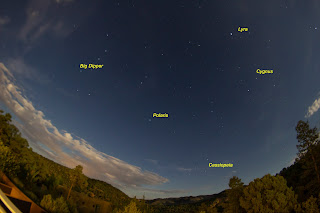Sh2-94 - Part of a Large Supernova Remnant (2022) Sharpless 94 (Sh2-94) is a part of a very faint supernova remnant (SNR) which includes Sh2-91 and SH2-96. This nebula has quite a bit of oxygen as well as hydrogen which are producing the ropy red and blue strands. I have already imaged Sh2-91 as a mosaic and planned to do Sh2-94 as another mosaic but the second panel did not come out well (the moon was out most of the time and is now out of my reach). Too bad as I imaged it over several nights but that is the breaks - so this is only the first panel. The red and blue strands are all filaments of the SNR with a diameter of about 230 light-years (70 parsecs) and an age approximately 30,000 years. It is located in Cygnus very close to the Veil Nebula but further away at 2500 light-years (Ly) as opposed to 1500 Ly for the Veil and it is four times older.
I like how this came out even though it is framed kind of weird due to my failed attempt at a mosaic. I will plan to do this whole thing next year when it becomes visible again and I have time to properly plan the mosaic. I used some new methods of color masks thanks to Bill Blanshan (and thanks to Cuiv the Lazy Geek for making the video). Bill's color masks worked incredibly well at making the red and blue nebulosity so I could then make adjustments to them. In addition, I have been using StarXTerminator by Russell Croman for quite a while but I just purchased his NoiseXTerminator and was most pleased with that as well. I did my standard reduction and probably could have done more, however, the starfield was very rich and colorful so I did not go further.
https://www.instagram.com/astroquest1/
http://astroquest1.blogspot.com/
https://www.astrobin.com/users/kurtzepp/collections/
http://youtube.com/c/AstroQuest1
Sh2-94 - Part of a Large Supernova Remnant (2022)
Dates: 9-13, 9-14, 9-15, 9-17, 9-22, 9-23, 9-24
Camera: ZWO ASI1600MM-Pro
Telescope: Astro-Tech AT115EDT 115mm Refractor Telescope
Barlow: None
Focal Length: 805mm (644mm w/ FR)
f/7
Focal Reducer: 0.8x AstroTech Field Flatterner/Focal Reducer
Mount: Orion Sirius
Filter Wheel: ZWO EFW 8 x 1.25"
Filter: ZWO Ha, OIII, R, G, B
Focuser: ZWO EAF
Autoguiding: ASI120 Mini attached to an Agena 50mm Guide Scope/ZWO 60mm Guidescope
Exposure:
Plane1 - Ha 67 x 300, OIII 59 x 300, R 46 x 60, G 37 x 60, B 36 x 60
Gain: 139
Offset 20
Sensor Temp: -10 C
Processing: NINA, PixInsight, Photoshop, Topaz DeNoiseAI, StarXTerminator.
https://www.instagram.com/astroquest1/
http://astroquest1.blogspot.com/
https://www.astrobin.com/users/kurtzepp/collections/
http://youtube.com/c/AstroQuest1




































